Don’t become a victim of pickpockets in Europe! Below are 5 easy ways to prevent pickpockets from targeting you, and for keeping your belongings safe while you travel.
Disclosure: This post contains affiliate links. That means we may earn a commission when you use the links on this site to book a hotel, buy your travel insurance, shop for travel essentials, etc. Learn more here.
Back in 1997 or 1998, I visited Prague for the first time with my mom during a summer vacation from high school. We’d gone to London to visit my brother, and had decided to tack on a trip to Prague, which at the time was still being discovered by tourists less than a decade after communism’s fall and the 1993 Velvet divorce between the Czech Republic and Slovakia.
At first, everything was perfect. We ate like kings, and I distinctly remember ordering an entire pizza for about $2 Canadian. We bought garnet rings and bohemian glass, and rushed around the city seeing all the best things to do in Prague. In other words, we had a fantastic vacation.
And then IT happened. An IT that has become the stuff of family legends, and gets brought up anytime anyone travels anywhere, or in any discussion of fanny packs (that’s a bum bag to you Brits). An IT that involves a thieving band of youths, embassy assistance, and international money transfers, and – when timed correctly – still causes us to fall into gales of laughter at the utter pandemonium and panic it immediately caused.
As it happens to thousands of other tourists each year, we fell victim to pickpocketing in Europe.
While riding up one of Prague’s famously long escalators out of a metro station, my mom’s fanny pack was unclipped and pickpocketed right off her waist.
My mom’s passport? Gone. Credit cards? Gone. All. Our. Cash? GONE.
It was a classic pickpocketing-by-distraction scam, and by the time we realized what had happened, it was too late. After reporting the pickpocketing incident to the police, we called my dad, who wired money to us via Amex. We went to the Canadian embassy to get an emergency replacement passport. And we did our best to enjoy the rest of the trip, while mostly just travelling back and forth, all day, between the embassy and the AMEX office.
Everything worked out, with nothing more than some light injuries to pride and some cash, and what is now a hilarious story to look back on. But at the time – man – what a pain in the behind that was. What was stolen didn’t amount to that much in the grand scheme of things, but the hassle was immense, both during the trip and after.
That experience instilled in me a great desire to never again be pickpocketed while travelling. And luckily, we haven’t.
Despite travelling to loads of places in which we’ve worried about pickpockets, Geoff and I have managed to avoid having anything stolen on our travels. In more than 16 years of travel, we haven’t had a single pickpocketing or theft experience (knock on wood). Even when we lived in Prague – a known European pickpocketing hot spot – we were okay! And that’s largely due to the precautions we take to keep our stuff safe while on the road.
Popular Pickpocket Spots & Scams in Europe
Where PickPockets in Europe Operate
Fortunately, Europe is relatively safe for travelers when it comes to physical safety.
Unfortunately, Europe is full of pickpockets, and the places most travellers want to go — think Paris, Rome, Prague… — are the very same places the most pickpockets operate. Often, the same set scams play out year-after-year in Europe’s pickpocket hotspots.
- The fundraiser scam, where faux charity workers approach you to sign a petition or donate money. In the case of signing a petition, they try to distract you so you can be lifted of your belongings. In the case of a donation, they simply keep your money.
- The bird mess scam, where someone discreetly squirts “bird poop” on your clothes, points it out to you, and offers to help you get cleaned up. As you’re being cleaned up by the good samaritan, their accomplice will nick your wallet or bag.
- A distraction of any sort, where one person bumps into you, or captures your attention, while their accomplice grabs your wallet and bag, and either runs, or passes the loot who someone who does.
Beyond these basic pickpocketing schemes, also be aware of scams to get you to hand over your money voluntarily:
- You see someone drop their wallet/cash on the street, pick it up and move to run after them like the good samaritan you are. A third person approaches the scene (who is an accomplice to the person who “accidentally” dropped their wallet), accuses you of trying to steal the wallet, and demands money to not turn you into the police. This one is currently popular in Ukraine, and we walked past some dropped money on the street just yesterday!
- This is similar to the “gold ring” scam, where a stranger pretends to find a gold ring on the ground and generously gives it to you, but demands money if you take it (or has an accomplice pickpocket you while you’re distracted).
- Along a similar vein, someone will crash into you and then accuse you of breaking something (glasses, etc., which were in fact already broken). They’ll try to make you compensate them for whatever it was you “broke.”
- A friendly local will come “give” you something as a gift of friendship, and then demand money for it. This seems to most often happen with bracelets (which they tie very tightly to your wrist) or bundles of sage (this one is common in southern Spain – whenever we saw women with bundles of sage, we’d yell “OCCUPY HANDS” to each other, and shove our hands in our pockets so they couldn’t force the sage into our hands!).
- In places where police corruption is an issue, it’s not uncommon for real police officers to stop you and try to exact a bribe. We had this happen to us in Mexico: we were pulled over for speeding (which we weren’t), and when Geoff handed over his license, the police officer held it hostage: we were given the option to pay an on the spot “fine” or have Geoff’s license revoked for a week.
Preventing Pickpockets in Europe
I like to think one of the reasons Geoff and I have managed to avoid being pickpocketed is that we’re hyper-aware of what’s going on around us, and we do our best to minimize the risk. Surely there are dozens of things you can do to protect your wallet and belongings while travelling Europe (or anywhere) – here’s a list of the things we’ve learned over the years!
1. Keep Your Zippers Zipped
One of the best ways to prevent pickpocketing while traveling is to prevent potential thieves from accessing your stuff – your wallet, passport, your camera, etc. And we do this is by taking a few small precautions to keep our day bags, camera bags and my purse shut tight, especially when I’m in a crowd.
If I’m buying a new bag, I evaluate them based on two features: straps/cords, and zipper sliders.
On purses, I look for a purse that closes with single zipper and has a wrist strap attached to the slider part of the zipper, or a bag with the capacity to attach a wrist strap I can buy and attach separately. When I’m in a crowd, I orient the shoulder bag so the zipper closes at my front, and then stick my wrist/forearm through the strap to ensure the zipper stays shut (this technique has the added benefit of making it difficult to grab and run with your bag).
When I’m carrying my camera, I typically use the Lowepro Passport Sling bag, which has a tiny feature I’ve come to love: cords attached to the zipper sliders.
Take a look at the picture – if you look closely, you can see the black cords attached to both the front and back zipper sliders (circled in red). When we’re in a crowd, I close the bag to orient the two zipper sliders together at the front of the bag, and then I stick my thumb through the two cords to keep them securely together.
(I also like this bag because I can swing it around to the front of my body to protect the camera when we’re in a crowd, on a bus, etc.)
This strategy doesn’t have to cost you anything. If you already have a bag you love, and don’t want to buy something new, you can always DIY these two concepts with ribbons, cords, hair elastics…whatever.
I also travel with mini, double-ended carabiners and use them regularly to keep my bag zippers together. They’re a cheap and effective solution — while the carabiner won’t prevent someone from getting into the bag if they really want to, it is a deterrent and is easier than locking and unlocking a luggage lock everytime you want to buy a latte.
COST: Anywhere from free (using elastics, etc., you have around the house) to $90, for an awesome theft-proof bag.
When it comes time to buy a new purse, I’ll probably buy an anti-theft travel purse, which have specific features for keeping your zippers shut. The Pacsafe Citysafe bag, for example, has a zipper fastener feature that ensures pickpockets can’t get into your bag. Further, they are slash proof to foil really eager pickpockets and thieves.
2. Use the Power of Layers to Foil Pickpockets in Europe
This is a trick we started doing in South America, on long bus rides at night or while walking across some of the more colourful border crossings, where shady characters abound. It worked well for keeping our passports, wallets, cash and cards secure, so we’ve kept it up.
The trick is to wear two layers when you know you’re going to be in a situation where your stuff isn’t secure, with an inner layer that has zipper pockets to store your stuff, and an outer layer to cover it up.
We’ll often use this for overnight or long train trips in Europe, when we need access to our passports while crossing borders, but don’t want to wear a money belt (which I find horribly uncomfortable).
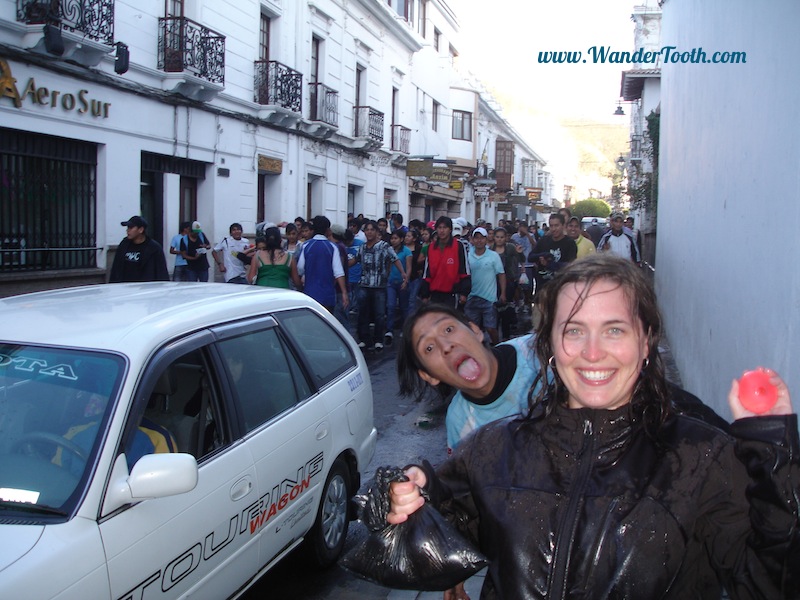
How we layer across the seasons:
Winter: I use a North Face fleece with zip pockets paired with either a long, trench-style raincoat, a windproof/waterproof soft-shell, or whatever cheap winter coat I happen to have.
Spring and Autum: I’ve found athletic shirts made for yoga and running often come with zipper pockets, which I wear under my trench-style raincoat.
Summer: Summer is trickier, as most quite reasonably people don’t want to wear layers when it’s 30 degrees out. The best I can find are the tanks, t-shirts (and also underwear!) made by Clever Travel Companion, which all have secret pockets. For example, they have a light tank with a pocket in the front, and if you buy a snug one you can throw another light shirt over top without it getting in your way.
A Clever Travel Companion tank and t-shirt with zippered pockets for layering.
COST: Free if you have the right clothes, or $30 or so for a base layer tank/very top with a zippered pocket.
3. Use Hidden Pockets and Sneaky Hiding Spots to Hide Your Valuables from Pickpockets
This is as much about preventing your things from being stolen as it is about having a back-up plan, just in case you do get pick-pocketed. We try to split up our cards and cash in sneaky ways so if one stash gets taken, we’ve got more.
Under a Shoe Insert — Keep a bit of extra cash in a zip-lock bag under the insert in a running shoe or boot.
Secret pocket scarf — This is such a brilliant idea, I wish I thought of it: an infinity scarf with a secret zipper pocket to stash your phone, passport, cash, etc. There are loads of styles to choose from, and they’re not at all expensive. I travel with an infinity scarf anyway, and when I need to replace my current one, I’ll be getting one of these.
Arm Cuff — These are cute, especially if you’re going out for the evening or for a run, and you don’t want to carry anything. They look like a wide cloth bracelet or really short arm warmer, but come with a place to store a bit of cash and some cards. I can also see these being a handy spot to keep a bit of cash if you’re heading out to shop at a market, but don’t want to pull your wallet with all your money out, or if you’re in a country where ‘grab and run’ style theft is common and dangerous (i.e. taking moto taxis in Cambodia).
Sew-In Pockets — If you’re really concerned, you can get zippered secret pockets that are meant to be sewn into your pants, or wherever else you want to keep your valuables. I would probably consider these if we were going somewhere with a high crime rate, and I’d only store extra emergency cash in them rather than things I need everyday access to.
Secret Pocket Under Things– You can get both men’s versions and ladies’ versions of secret pocket underwear. Travelon makes socks with a zippered pocket to stash some extra cash. And for women, you can also get snap-on secret pockets for your bra (this honestly sounds uncomfortable to me, but it’s an option, nonetheless.)
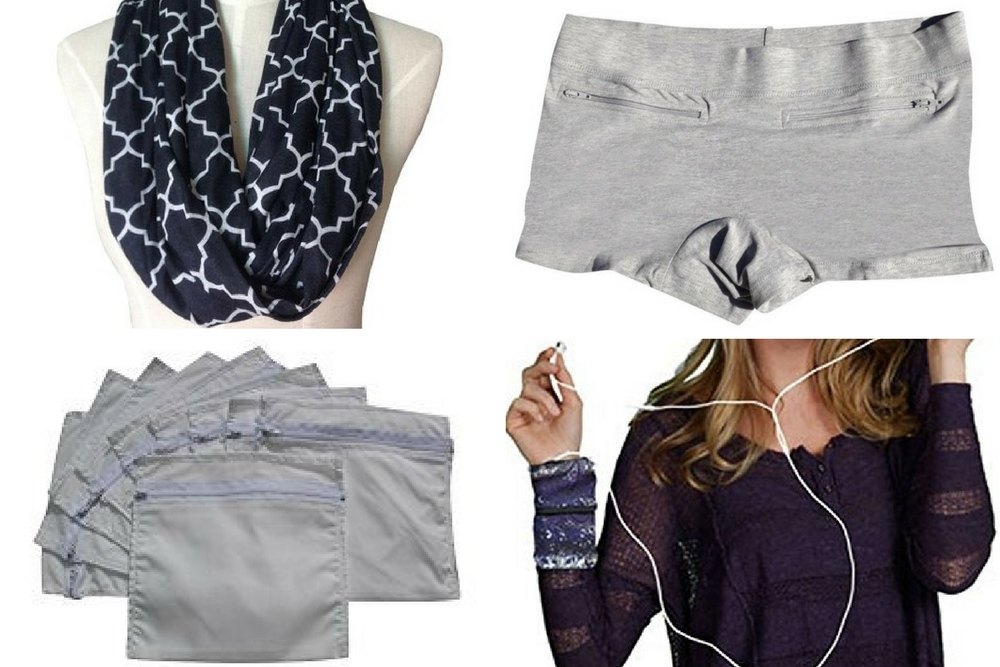
Cost: Stuffing money and cards under your shoe will only cost you the (highly recommended) plastic baggie to protect it from the elements. Most of these other items can be got for between $11 and $30.
If you want to travel with a money belt, we’d suggest you use the style you wear around your waist (under your trousers) rather than the neck pouch style. Neck pouches are very easy to cut off quickly and without you noticing.
4. Attach Your Luggage, Bags and Phone to Something
For luggage, we tend to use cable locks rather than padlocks, because we find them more versatile.
When we’re staying in hostels without lockers, we’ll thread the cable through luggage zippers, and lock our bags together: our thinking is, it’s tough to casually walk out with a lump of three bags that are all locked together. When we’re on a train, we’ll use the cable to lock the luggage to the luggage rack, so a thief doesn’t jump off at the wrong stop with our bags (this double cable lock looks great for this).
When we’re out sitting at a café or restaurant, we always secure our bags to a table or chair:
- If you have a backpack with waist or chest straps that clip together, clip them around a piece of the table or chair so someone can’t grab and run with your bag.
- If you don’t have straps that clip together, loop a strap around your leg, or put it around a chair leg before sitting down.
- You can also carry a short luggage strap with a quick release buckle to loop through your bags and attach them to a table, etc.
If you’re worried about your phone, check out the Lockable Smartphone Leash, recommended to us by a world-travelling friend who uses and loves it. It’s a bungee that tethers your phone to your bag, letting you use it without worrying about dropping it or having someone grab it our of your hand or off a table.
Cost: Between $7 (for a luggage strap) to $30 (for the phone leash).
5. Be Discreet So You Don’t Attract Pickpockets
Picture this scene, which we actually witnessed earlier this year in Playa del Carmen, Mexico. We were walking from our Airbnb to a restaurant to get a bite to eat, and needed to stop at the ATM for some cash.
As we almost always do, Geoff went into the ATM vestibule, and I stayed outside (this is also a safety habit). Inside the ATM vestibule were an English-speaking couple, probably either Canadian or American. They were well-dressed, and the woman was wearing expensive-looking diamond rings.
They were also having trouble figuring out the ATM. Rather than figure it out themselves, or go to another ATM, they asked the person in line behind them to HELP THEM TAKE CASH OUT OF THE ATM!!! Once they had the cash (a massive, massive wad of it, BTW), they didn’t immediately put it in their wallet, walking outside the vestibule onto the street with a massive wad of cash, counting it in plain site, and then putting it in his wallet.
This, my friends, is the definition of how to become a target of pickpockets, or worse. Don’t be like this couple. Be discreet with your cash and your belongings:
- Leave the expensive jewellery at home. My engagement ring and wedding band live in a safety deposit box in Canada when we’re away, in favour of a simple white gold wedding band that I bought for less than $100.
- Take the Canon-branded (or Nikon, or Sony) camera stop off your DSLR, and replace it with something plain and unbranded. I use the RapidStrap RS-7 camera strap, which has the added benefit of letting me carry my camera down by my hip, which is more discrete than around my neck.
- Cover-Up electronics brands with plain sleeves, cases, etc. Grab a plain iPhone case, laptop cover, etc., and leave the rhinestone-encrusted version at home.
- Don’t throw your wealth around. Before leaving the ATM, put your cash away. Don’t fill your wallet with cash, opening it for vendors and others to see every time you make a purchase. If need be, carry a dummy wallet with a bit of cash, and a real wallet that you don’t pull out in crowds. Leave expensive handbags and accessories at home, in favour of plain, non-descript ones that don’t draw attention.
Cost: FREE! It costs nothing to take a bit of care and be more discrete – all these other items are extras.
Have you used any of these tips or travel gear to prevent pickpockets, or have you been a victim of pickpocketing in Europe? Share your stories in the comments or send us a message!


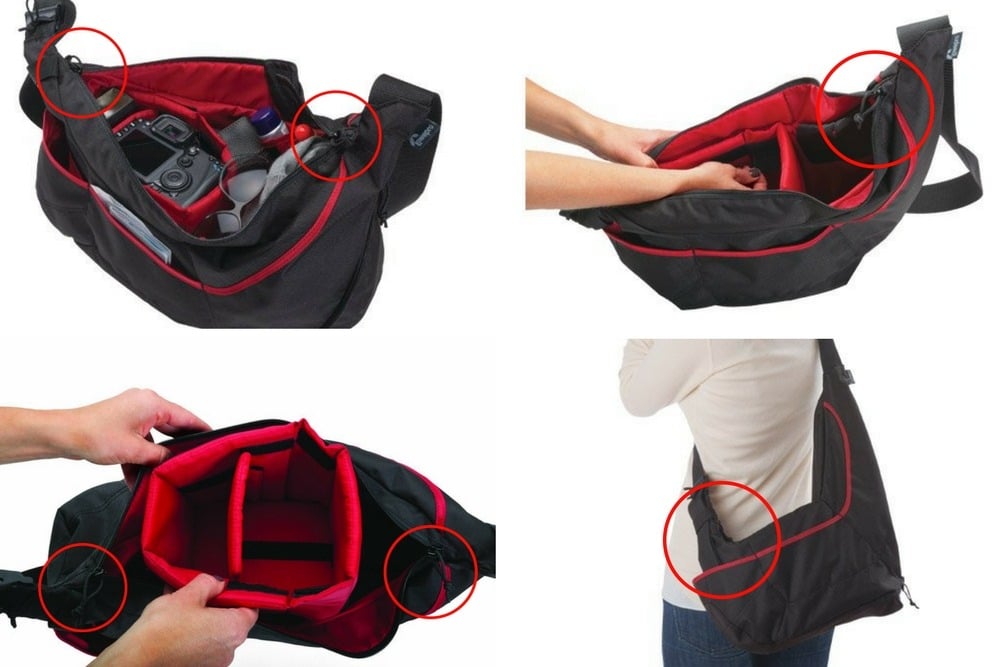
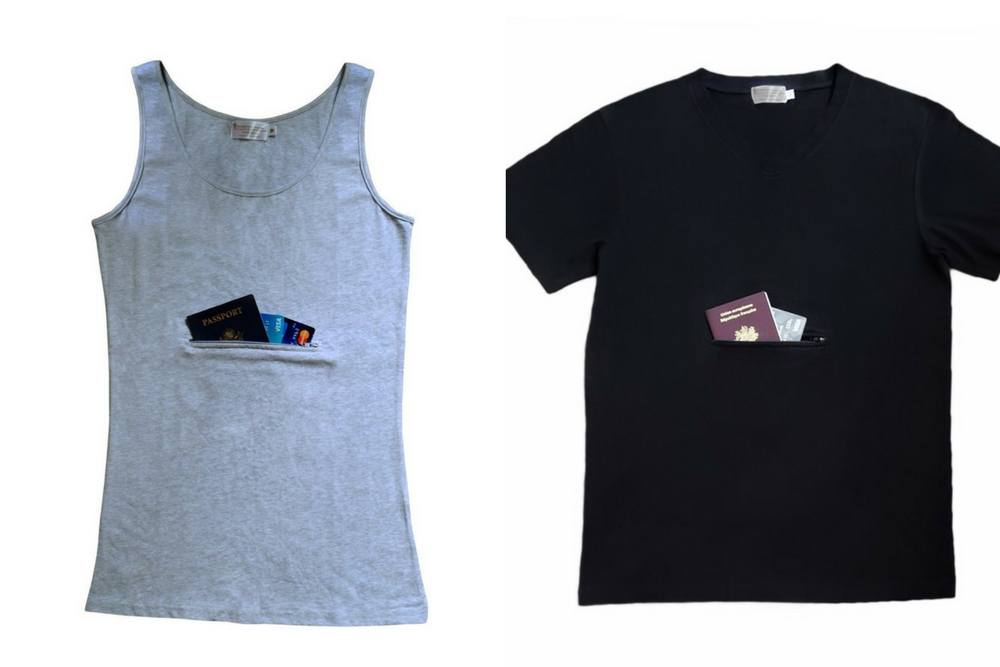
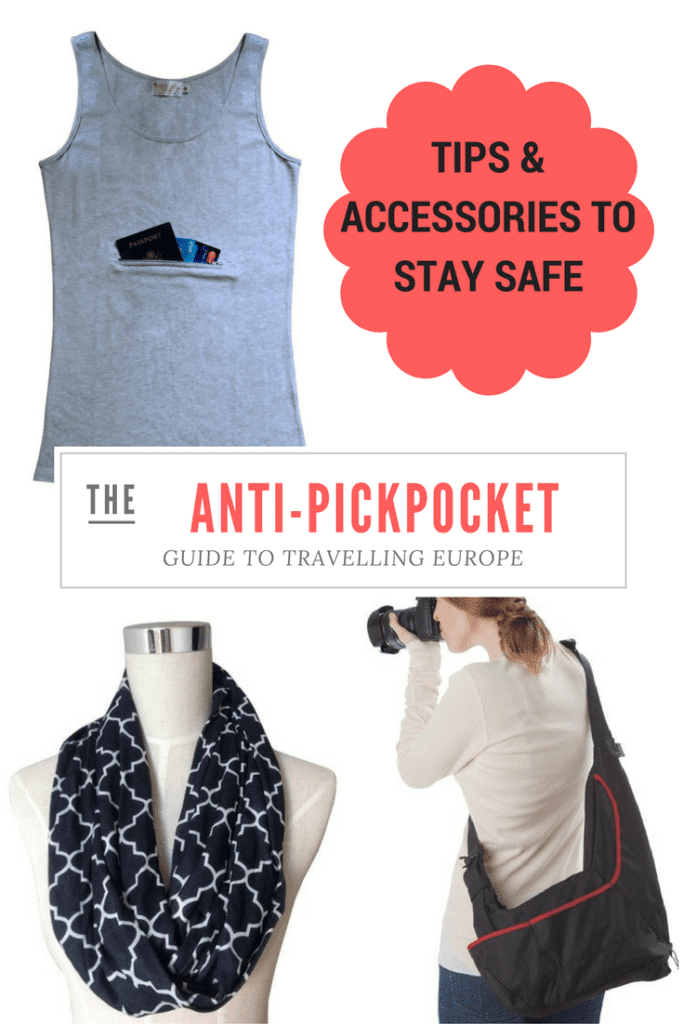
Without jinxing myself, I have never had anything stolen when I traveled or in my country. On the other hand , I am born in Eastern Europe and we learn to deal with shady areas – i.e. markets! – right about when we start going to school.
My tricks? I always keep the valuables – money , ID cards, phone – in the most hidden pocket in the day pack.
I had my front pocket open when coming from school one day – I only had tissues in there. You should have seen the face on the person who opened it :)
My rule of thumb is to just be aware of the surroundings and don’t look like a tourist. Sorry,no fanny pack here :))
This is an incredibly informative post. Thank you! I’m a fairly novice traveler and have had very good luck when I am traveling. Now I have kids, so I’d be a prime and easy target in some of these areas. I’m often distracted! I am glad to see a guide like this with many practical and easy-to-implement suggestions.
Sorry to hear about the theft in Prague. The behavior of the non-discreet couple at the ATM was definitely surprising.
Pingback: Where To Stay in Madrid: Madrid's Coolest Neighbourhoods and Places to Stay
If i am going out in Paris,i will either have a manbag,on my front,or take a little money and my phone,in my front pocket trousers,i wonder how safe that is.
Hi James,
We’ve never had problems in Paris, although there definitely are some well-known scams. I think in general, being aware of what’s going on around you and taking the small steps (such as the ones you mentioned), should be enough. Geoff always puts his phone and wallet in his front pocket when in crowds especially.
Have fun in Paris – such a beautiful city!
Pingback: Solo Travel Tips: Amsterdam, The Netherlands | Solitary Wanderer
Such great advice and suggestions..We have travelled alot through Europe and also have a few standard things we do in additon. I have a crossbody theft proof bag from Travelon. This bag has fine wire sewn into the material which prevents any slash and grabs, also all the zippers clip shut onto another ring, takes alot of work to open. Inside the bag are clips where you can attach your wallet. Here I attach a coil strap to and use the wallet always connected. One possible theft attempts are when they will slash your bags at the bottom and wait for your valuables to start dropping out. So securing inside your purse/bag is advised. My husband and I rarely walk side by side, he’s a bit behind. Our eyes are always paying attention to surroundings.. We have a code word “shadow left/right or behind” this alerts the other that we may be targeted. Works great..We then just stop, and pretend to look into a store. Your splitting up money between you, and stashing is perfect, everyone should be doing that..We also take copies of everything; eg; credit cards, passports etc.and email them to ourselves, so if we lost anything we can access the info from our email. We also try never to pay attention (hard to do sometimes) to a situation where we would normally help someone. Eg; had a lady with a child “accidentally” drop her packages, and dump her purse out..distressed to see who would help her. There were 2 fellows watching her, probably waiting for someone to be distracted helping her..Anyway..I could go on..but I feel this is way too long for just a comment…LOL…happy travels…Life is short..buy the shoes :)
Pingback: A Day in Sintra: The Best Spots to Visit on a Lisbon Day Trip to Sintra
Pingback: The Only Scotland Packing List You’ll Ever Need: What to Pack for Scotland in All 4 Seasons
Pingback: The Only Spain Packing List You'll Need: What to Pack for Spain for All Seasons